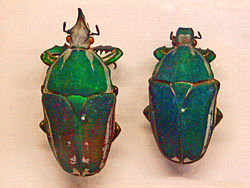| Mecynorhina torquata | |
|---|---|
 | |
| Mecynorrhina torquata, male and female. Mounted specimen at the National Museum (Prague) | |
| Scientific classification | |
| Kingdom: | Animalia |
| Phylum: | Arthropoda |
| Class: | Insecta |
| Order: | Coleoptera |
| Suborder: | Polyphaga |
| Infraorder: | Scarabaeiformia |
| Family: | Scarabaeidae |
| Genus: | Mecynorhina |
| Species: | M. torquata |
| Binomial name | |
| Mecynorhina torquata (Drury, 1782) | |
| Synonyms | |
| |
Mecynorhina torquata is a beetle from the subfamily Cetoniinae, tribe Goliathini.